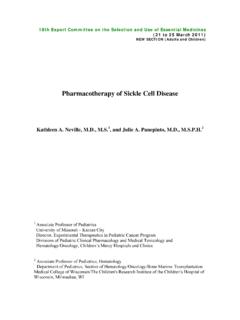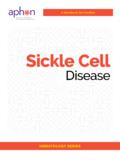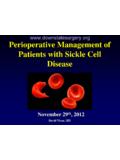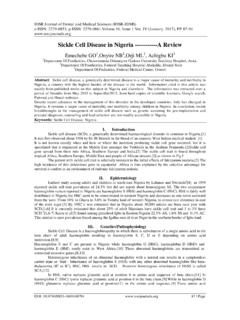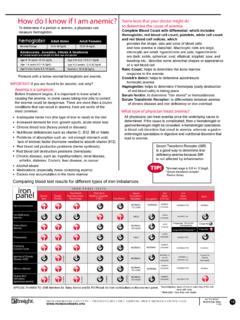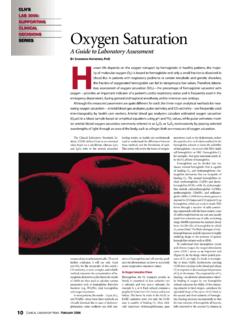Transcription of Study of surgical aspects of sickle cell disease ...
1 Indian Journal of Basic and Applied Medical Research; March 2015: , Issue- 2, P. 345-357 345 P ISSN: 2250-284X , E ISSN : 2250-2858 Review article: Study of surgical aspects of sickle cell disease - Pathophysiology with review of literature Dr Rahul Powar , Dr Vinod V Prabhu Assistant Professor in surgery , Bharati Vidyapeeth University, Bharati Medical College, , Maharashtra. India. Associate Professor in surgery , Bharati Vidyapeeth University, Bharati Medical College, , Maharashtra. India. Corresponding author: Dr Vinod V Prabhu Abstract: Objectives : To Study the surgical presentations of sickle cell anaemia (SCA) in a sickle cell belt in India and to discuss the historical aspects and pathophysiology of sickling and its sequelae. Methodology : One hundred patients attending the surgical outpatient were screened for sickle cell disease and the signs and symptoms were recorded as to the type of crisis they presented with.
2 Results: Out of a hundred patients included in this Study ninety patients presented with SCA and ten with sickle cell trait (SCT). 53% patients presented with vasoocclusive crisis. Leg ulcers and abscesses formed the next most common modes of presentation. Wound infection and delayed wound healing were the most commonly occuring complications. Conclusion: Patients of sickle cell anaemia presented mainly with vasoocclusive crisis requiring a proper evaluation and careful management of surgical procedures. Distinguishing between vasoocclusive crisis or surgical cause of abdominal pain is paramount to avoid unnecessary surgical procedures. surgical patients require proper hydration, blood transfusion and proper oxygenation to avoid post operative complications. Use of minimal invasive surgical techniques wherever possible obviates complication rate.
3 Proper genetic counseling of susceptible population is essential. Keywords: sickle cell disease , vasoocclusive crisis, abdominal pain, drepanocytosis Introduction: sickle -cell disease (SCD), also called drepanocytosis, is a hereditary blood disorder, characterized by an abnormality in the oxygen-carrying haemoglobin molecule in red blood cells that leads to a tendency for the red cells to assume an abnormal, sickle -like shape under certain circumstances. sickle -cell disease is associated with acute and chronic diseases, such as severe infections, attacks of severe pain (" sickle -cell crisis"), and an increased risk of death. sickle -cell disease occurs when a person inherits two abnormal copies of the haemoglobin gene, one from each parent.
4 sickle cell anemia (SCA) results from substitution of a single amino acid, namely valine for glutamic acid in the beta globin gene at chromosome number 11.[1] The susceptibility of red cells to sickle correlates well with the concentration of sickle haemoglobin within the red cells . Several factors influence the course and severity of the disease . These include the presence or absence of alpha thalasaemia Indian Journal of Basic and Applied Medical Research; March 2015: , Issue- 2, P. 345-357 346 P ISSN: 2250-284X , E ISSN : 2250-2858 gene, oxygen content of the inspired air, cardiac and pulmonary status. Other factors such as dehydration, infection, acidosis and hypothermia may precipitate some of the disease complications. Several subtypes exist, depending on the exact mutation in each haemoglobin gene.
5 A person with a single abnormal copy is usually asymptomatic and is said to have sickle cell trait. This prospective Study in a sickel cell belt in India aims to Study various surgical presentations in sickle cell disease patients coming to the department of surgery ; Study various complications in sickle cell disease patients and to find the association between sickle cell disease and surgical presentation. Historical aspects : sickle cell disease has been known to people from West Africa from several centuries. The tribal people gave unique names to it, which were onomatopoeic and imitated the cries and moans of the sufferer. All these names repeating syllables , possibly denoting the repetitive painful episodes.
6 Some of the names included nwiiwii (Fante tribe), chwecheechwe (Ga Tribe), nuidudui (Ewe Tribe).One of the earliest papers describing SCD in the West was published in 1846 [2], in Southern Journal of Medical Pharmacology titled case of Absence of Spleen. It mentioned the autopsy findings in a slave who had been executed. Symptoms of SCD could be tracked back to year 1670 in one Ghanian family.[3] The credit of discovery of sickle cell disease goes to Dr. James Herrick, who provided the first formal description of sickle cell anemia when he reported that the blood smear of a dental student at the Chicago College of Dental Surgery contained "pear-shaped and elongated forms" in 1910. Six years earlier ( in 1904) he had examined a twenty year old Caribbean, Walter Clement Noel, a dental student who had been admitted to the hospital with cough and fever.
7 Examination of the blood smear revealed the presence of unusual red cells which were described by Herrick in the following words, the shape of the red cells was very irregular, but what attracted attention was the large number of thin, elongated , sickle -shaped and crescent-shaped forms. Cook and Meyer (1915) were the first to suspect a genetic basis for the disease as three siblings of their patient had died due to severe anemia. Sickling was demonstrated by them both in the patient and her asymptomatic father. The term " sickle cell anemia" was first coined by Mason in 1922. In 1923 Taliafero and Huck hypothesized that, the sickle cell disease is an inherited disease and the mode of inheritance is based on Mendelian recessive character.
8 In 1924, it was Sydenstiker , who gave the first details of clinical description of sickle cell disease and introduced the term crisis seen during the course of the disease . Hahn and Gillespiell (1927) documented the role of reduced oxygen tension and reduced pH in in-vivo production of sickle cells . Waugh and Servier et al (1930) showed that the sickling process is directly dependent on hypoxia and increased carbon dioxide which induce the process of sickling. The Study of Diggs et al (1939) revealed the irreversible sickle cells which do not revert to its original shape after deoxygenation. Sherman (1940) reported that the sickling of red blood cells in the absence of oxygen is caused by a change in the hemoglobin molecule structure.
9 Janet Watson (1948) suggested that the Indian Journal of Basic and Applied Medical Research; March 2015: , Issue- 2, P. 345-357 347 P ISSN: 2250-284X , E ISSN : 2250-2858 presence of fetal hemoglobin in the red blood cells of sickle cell newborns is the reason they do not show disease symptoms. Physical chemist Linus Pauling and associates (1949) explained how protein electrophoresis showed that the sickle cell hemoglobin differed in structure from the normal hemoglobin moeity. This was the first time that the cause of a disease was linked to a change in protein structure. Vernon Ingram and Hunt (1956) sequenced sickle hemoglobin and showed that glutamic acid at position 6 was replaced by a valine in sickle hemoglobin. Using the known information about amino acids and codons that coded for them, he was able to predict the mutation in sickle cell anemia.
10 This made sickle cell anemia the first genetic disorder whose molecular basis was known. Konotey Ahulu 5 (1974), presented the summary of clinical manifestations of the disease and classified the crisis. Walter Gilbert and Frederick Sanger ( 1977), working separately in the United States and England, developed a new technique for rapid DNA sequencing. This led to the identification of the mutation in the beta globin gene. Dr. Charache reported that the anticancer drug hydroxyurea is the first to reduce the frequent, painful complications that characterize sickle cell disease . Geographical distribution of sickle cell disease [4]: SCD presents a major medical problem in tropical Africa, the Caribbean, the Middle East and the Indian subcontinent.
